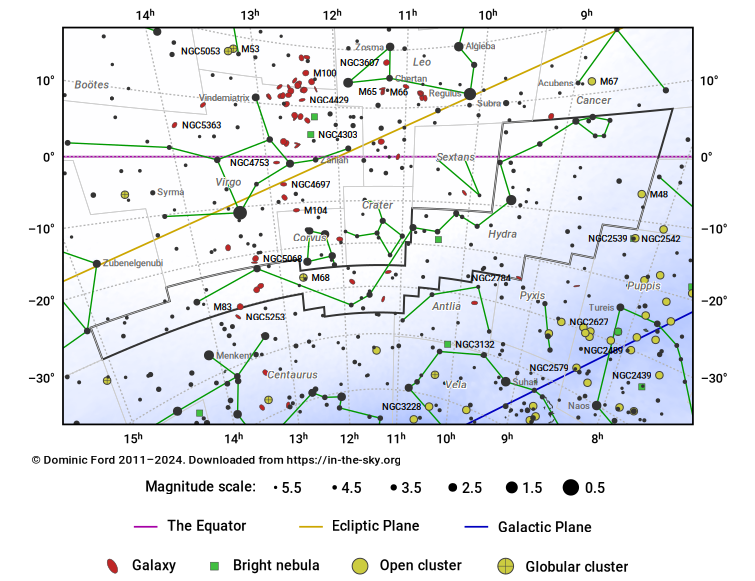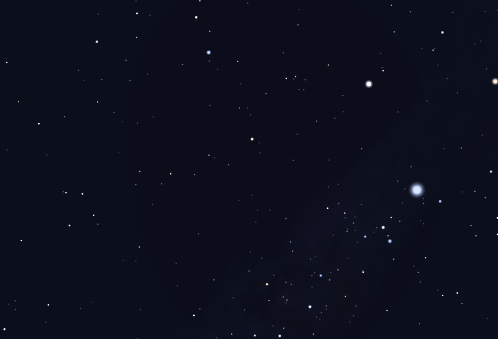The Constellation Hydra
Hydra is the largest of all the constellations, visible in a equatorial and southern evening sky in the months around January and February.
Named after a water snake, Hydra is a long thin constellation, whose head lies slightly north of the celestial equator, but whose tail dips below a declination of 30°S. The angular distance between the head and tail of the snake is 85°.
Despite its large size, Hydra is a faint constellation with only one star brighter than third magnitude. The snake traces a path roughly parallel to the plane of the Milky Way and roughly 20° to its north. It is home to a few bright deep sky objects, including the open cluster M48, the galaxy M83 and the globular cluster M68.
In Greek mythology, Hydra is often identified as the Lernaean Hydra, a multi-headed creature slain by Hercules. According to various authors, the monster had six, nine, or even fifty heads, and perhaps even grew back a pair of heads for each one severed by Hercules. In the sky, however, it is depicted with only one head.
According to another myth, Hydra is the water snake in the tale of the crow and the cup, Corvus and Crater.
Ancient
3.2% of the sky
1302.8 square degrees
Hover the pointer over the name of an object to highlight its position on the starchart to the right, or click to see more information.
| Stars | Open Clusters | Globular Clusters | Galaxies |
| Alphard (mag 2.0) | Messier 48 (mag 5.8) | Messier 68 (mag 7.3) | Messier 83 (mag 7.2) |
| γ-Hya (mag 3.0) | NGC 3621 (mag 9.6) | ||
| ζ-Hya (mag 3.1) | NGC 3923 (mag 9.6) | ||
| ν-Hya (mag 3.1) | NGC 3585 (mag 9.7) | ||
| π-Hya (mag 3.2) | NGC 2784 (mag 10.1) | ||
| ε-Hya (mag 3.4) | NGC 5061 (mag 10.3) | ||
| ξ-Hya (mag 3.5) | NGC 5101 (mag 10.5) | ||
| λ-Hya (mag 3.6) | NGC 3109 (mag 10.5) | ||
| μ-Hya (mag 3.8) | NGC 4105 (mag 10.6) | ||
| θ-Hya (mag 3.9) | NGC 2835 (mag 10.6) | ||
| C-Hya (mag 3.9) | NGC 2986 (mag 10.6) | ||
| ι-Hya (mag 3.9) | NGC 5078 (mag 10.6) | ||
| υ¹-Hya (mag 4.1) | NGC 3904 (mag 10.8) | ||
| δ-Hya (mag 4.1) | NGC 3091 (mag 11.0) | ||
| η-Hya (mag 4.3) | NGC 2855 (mag 11.1) | ||
| D-Hya (mag 4.3) | NGC 3078 (mag 11.2) | ||
| ρ-Hya (mag 4.3) | NGC 2935 (mag 11.2) | ||
| β-Hya (mag 4.4) | NGC 3717 (mag 11.2) | ||
| E-Hya (mag 4.4) | NGC 4106 (mag 11.3) | ||
| σ-Hya (mag 4.4) | NGC 3311 (mag 11.3) | ||
| τ²-Hya (mag 4.6) | NGC 2811 (mag 11.4) | ||
| υ²-Hya (mag 4.6) | NGC 2865 (mag 11.5) | ||
| τ¹-Hya (mag 4.6) | NGC 3054 (mag 11.5) | ||
| F-Hya (mag 4.6) | NGC 2781 (mag 11.6) | ||
| 2-Sex (mag 4.7) | NGC 3673 (mag 11.6) | ||
| O-Hya (mag 4.7) | IC 4351 (mag 11.6) | ||
| G-Hya (mag 4.7) | NGC 2665 (mag 11.6) | ||
| I-Hya (mag 4.7) | NGC 2907 (mag 11.6) | ||
| 26-Hya (mag 4.8) | IC 2597 (mag 11.7) | ||
| k-Hya (mag 4.8) | IC 3829 (mag 11.7) |




